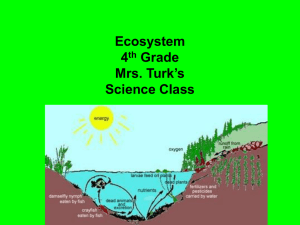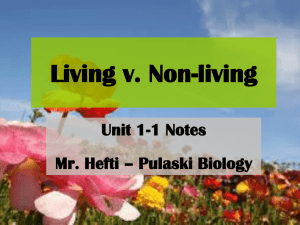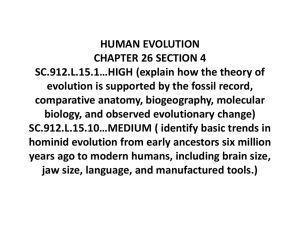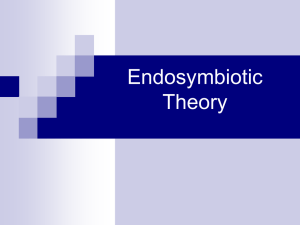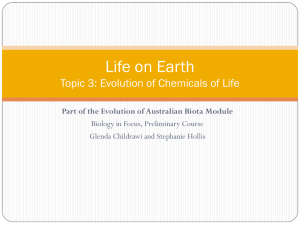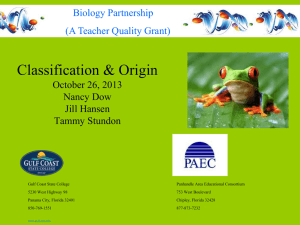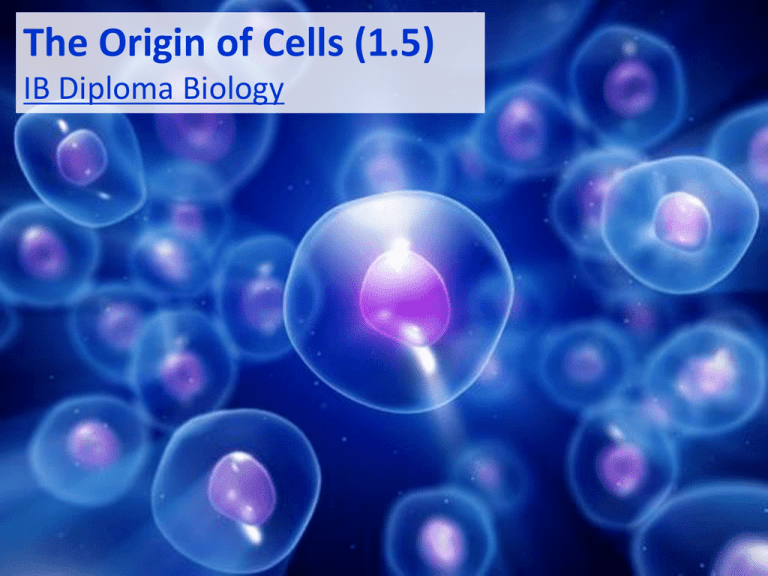
The Origin of Cells (1.5)
IB Diploma Biology
Cell theory states that:
• All living things are composed of cells (or cell products)
• The cell is the smallest unit of life
• Cells only arise from pre-existing cells
Source: http://www.engr.uconn.edu/alarm/research?id=63
1.5.1 Cells can only be formed by division of pre-existing cells.
Cells can only be formed by
division of pre-existing cells:
• Cells multiply through division
• Mitosis results in genetically identical
diploid daughter cells
• Meiosis generates haploid gametes
(sex cells)
4-cell stage of a sea biscuit by Bruno Vellutini on Flickr
(CC) http://flic.kr/p/daWnnS
1.5.4 Evidence from Pasteur’s experiments that spontaneous generation of
cells and organisms does not now occur on Earth.
1864
Pasteur disproves the prevailing theory of “spontaneous
generation” with his swan-neck flask experiments.
Populations need to be seeded by existing populations: cells come
only from pre-existing cells.
1.5.1 Cells can only be formed by division of pre-existing cells.
What evidence do we have (other
than Pasteur’s experiments) to
support this theory?
4-cell stage of a sea biscuit by Bruno Vellutini on Flickr
(CC) http://flic.kr/p/daWnnS
1.5.1 Cells can only be formed by division of pre-existing cells.
1. Cells are highly complex
structures and no mechanism
has been found for producing
cells from simpler subunits.
http://upload.wikimedia.org/wikipedia/commons/thumb/3/3e/Eukaryotic_Cell_%28animal%29.jpg/1024px-Eukaryotic_Cell_%28animal%29.jpg
1.5.1 Cells can only be formed by division of pre-existing cells.
2. All known examples of growth
be it of a tissue, an organism or a
population, are all a result of cell
division.
http://upload.wikimedia.org/wikipedia/commons/thumb/d/d3/Onion_root_mitosis.jpg/749px-Onion_root_mitosis.jpg
1.5.1 Cells can only be formed by division of pre-existing cells.
3. Viruses are produced from simpler
subunits, but they do not consist of cells,
and they can only be produced inside the
host cells that they have infected.
http://upload.wikimedia.org/wikipedia/commons/3/3a/Influenza_virus_particle_color.jpg
1.5.1 Cells can only be formed by division of pre-existing cells.
4. Genetic code is universal
each of the 64 codons (a
codon is a combination of 3
DNA bases) produces the same
amino acid in translation,
regardless of the organism.
The logical deduction is that all
cells have arisen as the result
of cell division from a single
common ancestor.
*
There are some minor variations that are likely to have accrued since the common origin of
life on Earth, but these are rare and most of the genetic code is universal most of the time.
http://www.slideshare.net/gurustip/protein-synthesis-35-transcription-translation-sl
1.5.2 The first cells must have arisen from non-living material.
If we accept that there were times in the history of the Earth when
cells did not exist then it is an obvious point that ‘The first cells
must have arisen from non-living material’. The only other possible
explanation is that life, in the form of cells, was transported here
from elsewhere in the universe.
Some of the key problems are:
1. Non-living synthesis of simple organic
molecules, e.g. sugars and amino acids
2. Assembly of these organic molecules
into polymers
3. Formation of polymers that can selfreplicate (enabling inheritance)
4. Formation of membranes to package
the organic molecules
1.5.2 The first cells must have arisen from non-living material.
Earth’s atmosphere was ‘reducing’ in the early days. It did not contain
oxygen gas until after plants started photosynthesising
The atmosphere contained:
Hydrogen
Nitrogen
Water vapour
Methane
Ammonia
Hydrogen sulfide
The gases came from
abundant volcanic activity
1.5.2 The first cells must have arisen from non-living material.
These monomers mixed in the ‘primeval soup’, shallow oceans laden with chemicals
where it is thought that they reacted to form biological molecules
Miller and Urey tried to recreate these conditions in the lab in 1953
They were trying to demonstrate
‘chemical evolution’, the
formation of more complex
molecules from simpler stock in
the primeval soup
They combined the molecules from the
previous page in a closed glass vessel
(simulated atmosphere), they heated
the water (simulated volcanic activity)
and sparked electricity through the
gases (simulated lightning)
1.5.2 The first cells must have arisen from non-living material.
After a week they found thirteen of the twenty naturally
occurring Amino Acids
Around 15% of the carbon was
now in organic compounds
1.5.2 The first cells must have arisen from non-living material.
1. Non-living synthesis of simple
organic molecules:
Miller and Urey recreated the conditions of prebiotic Earth in a closed system.
• These conditions included a reducing
atmosphere (low oxygen), high radiation
levels, high temperatures and electrical
storms
• Water was boiled to form vapor and then
was mixed with methane, ammonia and
hydrogen
• The mixture of gases was exposed to an
electrical discharge (sparks) to simulate
lightning
• The mixture was then allowed to cool and
after one week was found to contain
some simple amino acids and complex
oily hydrocarbons
• Based on these findings, it was concluded
that under the hypothesized conditions
of pre-biotic Earth, organic molecules
could be formed
1.5.2 The first cells must have arisen from non-living material.
2. Assembly of these organic molecules
into polymers:
Miller and Urey’s experiments allowed for the
formation of amino acids, but the conditions
used also tended to hydrolyze bonds preventing
polymers forming.
Deep-sea thermal vents…
• Fissures in a planet's surface from which geothermally heated water issues. Vents are
commonly found in volcanically active areas
• Along with heat energy the Vents issue a ready
supply of reduced inorganic chemicals
• Vents provide the right conditions (i.e. energy) and
chemicals to allow organic polymers to arise.
1.5.2 The first cells must have arisen from non-living material.
3. Formation of membranes to
package the organic molecules
• Experiments have shown that
phospholipids and other amphipathic
molecules natural assemble into
bilayers, if conditions are correct.
• Formation of the bilayer creates an
isolated internal environment.
• The formation of an internal
environment means that optimal
conditions, e.g. for replication or
catalysis can be maintained.
1.5.2 The first cells must have arisen from non-living material.
4. Formation of polymers that can self-replicate
(enabling inheritance)
• DNA though very stable and effective
at storing information is not able to
self-replicate – enzymes are required
• However RNA can store information
and self-replicate - it can catalyze the
formation of copies of itself.
• RNA molecules can catalyze reactions
(Ribozymes)
• In ribosomes RNA is found in the
catalytic site and plays a role in peptide
bond formation
1.5.3 The origin of eukaryotic cells can be explained by the
endosymbiotic theory.
Endosymbiotic theory explains the existence of several organelles of eukaryotes.
The theory states that the organelles (e.g. mitochondria and chloroplasts)
originated as symbioses between separate single-celled organisms,
Use the video and/or the tutorial to
understand how this occurred.
http://youtu.be/q71DWYJD-dI
http://highered.mcgraw-hill.com/sites/9834092339/student_view0/chapter26/animation_-_endosymbiosis.html
1.5.3 The origin of eukaryotic cells can be explained by the
endosymbiotic theory.
Development of the Nucleus
• A prokaryote grows in size and
develops folds in it’s
membrane to maintain an
efficient SA : Volume
• The infoldings are pinched off
forming an internal membrane
• The nucleoid region is enclosed
in the internal membrane and
hence becomes the nucleus
1.5.3 The origin of eukaryotic cells can be explained by the
endosymbiotic theory.
*
Development of Mitochondria
•
•
•
•
•
An endosymbiont
is a cell which lives
inside another cell
with mutual
benefit
The development of chloroplasts would be a
very similar process except the benefit to the
cell would be glucose/starch instead of ATP
An aerobic proteobacterium enters a larger anaerobic prokaryote (possibly as prey or a parasite)
It survives digestion to become a valuable endosymbiont*
The aerobic proteobacterium provides a rich source of ATP to it’s host enabling it to out-compete
other anaerobic prokaryotes
As the host cell grows and divides so does the aerobic proteobacterium therefore subsequent
generations automatically contain aerobic proteobacterium.
The aerobic proteobacterium evolves and is assimilated and to become a mitochondrion.
1.5.3 The origin of eukaryotic cells can be explained by the
endosymbiotic theory.
The evidence supporting the endosymbiotic
theory for mitochondria and chloroplasts:
• They have their own DNA (which is naked and
circular)
• They have ribosomes that are similar to
prokaryotes (70S)
• They have a double membrane and the inner
membrane has proteins similar to prokaryotes
• They are roughly the same size as bacteria and are
susceptible to the antibiotic chloramphenicol
• They transcribe their DNA and use the mRNA to
synthesize some of their own proteins.
• They can only be produced by division of preexisting mitochondria and chloroplasts.





